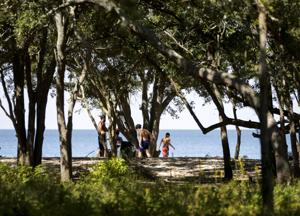
Brady Skaggs’ job involves helping keep Lake Pontchartrain clean enough for swimming. The native of Jacksonville, Florida is the Pontchartrain Conservancy’s water quality program director — and in the past he has used the lake to train for triathlons.
Skaggs studied microbiology at Georgia Tech before continuing his education at Tulane, where he received a doctorate from the School of Public Health studying water and wastewater disinfection technologies. He joined the Pontchartrain Conservancy in 2017, formerly known as the Lake Pontchartrain Basin Foundation. The Conservancy, created in 1989, aims to ensure the Pontchartrain Lake Basin is environmentally sustainable, prosperous and resilient.
Skaggs spoke to The Times-Picayune | The Advocate about the Pontchartrain Conservancy’s efforts in ensuring the lake stays clean. The conversation has been edited for length and clarity.
How does the Pontchartrain Conservancy help keep the lake clean?
We do that through a variety of different things: research, education, advocacy. What that means for us as far as improving water quality, we do a lot of routine monitoring. But we are usually providing on-site wa NO.cleanlake.032623 stewater technical assistance, whether it’s to on-site home systems or commercial systems. There’s this kind of fractured regional wastewater treatment scheme on the north shore, whereas almost all of the south shore is a community-based sewerage system. We also do some source tracking and technology development programs. But a common question is, why are we not only concerned with the lake? Well, we’re focused on a lot of the waters that go into the lake as well.
You said the north shore had a more regional sewer system. What does that mean?
There are many more systems on the north shore and they’re of much smaller design. So instead of having one permitted point source, there are several different smaller permitted sources on the north shore that go into the lake. And then you have lots of what’s called nonpoint sources. They’re not permitted under the auspices of the Clean Water Act, but they are small on-site wastewater treatment systems that serve one individual home. The wastewater treatment picture on the north shore is just a very different picture than what it is on the south shore.
What kind of water quality checks does the conservancy do? What do you test for?
We have a routine water quality monitoring program. There are 12 different sites — seven sites on the south shore and five sites on the north shore. We look for a variety of different meter-monitored, in situ collected measures or instantaneous measures. So temperature, dissolved oxygen, salinity, pH, and turbidity are all measured at the time that we go out with our field instruments. And then we collect water samples and have those analyzed in a lab for microbiological parameters. So we have three different microbiological parameters that are quantified, and then reported.
Based on those water quality checks, do we know that it’s safe to fish, boat, swim etc. in Lake Pontchartrain?
Safety is always a conversation about risk, what a person is prepared to accept. But since 2001, we’ve been collecting data on a routine basis. Prior to that, we worked with different partners like Tulane University and the Louisiana Department of Health to study the changes in the lake related to some of these fecal indicator bacteria. But with the termination of shell dredging, which disturbed the lake’s bottom sediments, a couple things have happened. Those sediments have a tendency to disrupt the natural ecology of the lake. It also disrupted the rangia clams that filter a lot of water and remove suspended sediments.
So has water quality improved in the Lake Pontchartrain Basin?
With the banning of shell dredging in the lake and lots of data collection over the years, the lake was removed from the impaired waterways list in 2006. So we had lots of swimming activities and people recreating in the lake. The water quality has greatly improved in the time that we’ve been out there collecting information and trying to improve water quality. But, going back to that point about safety, it’s not a pool. There are lots of things that can cause great harm or illness. Unfortunately, people have drowned. There are alligators out there and there’s sometimes rocks or other debris out there that could cause injury. So everybody needs to weigh the pros and cons.
Are there other animals people should expect or be wary of when they go into the Lake Pontchartrain Basin besides alligators?
Well, I mean, there’s wide classification of difference. Fish, and in some cases, you will see sharks out there. But I’m not necessarily an ecologist and we don’t necessarily take data for ecological purposes, but I have some teammates that have taken pictures of manatees just off the armored south shore near the lighthouse. There’s just a variety of wildlife that is out there. Way back when, I swam in the lake many times and trained for triathlons. And I always kind of figured my chance of some kind of animal attack is probably less than being hit by a car on a bicycle. It’s all an assessment of risk. There are some people that don’t see it as a significant risk and they’re out there swimming. There’s other people that are very cautious about jumping into the lake.

Leave a Reply